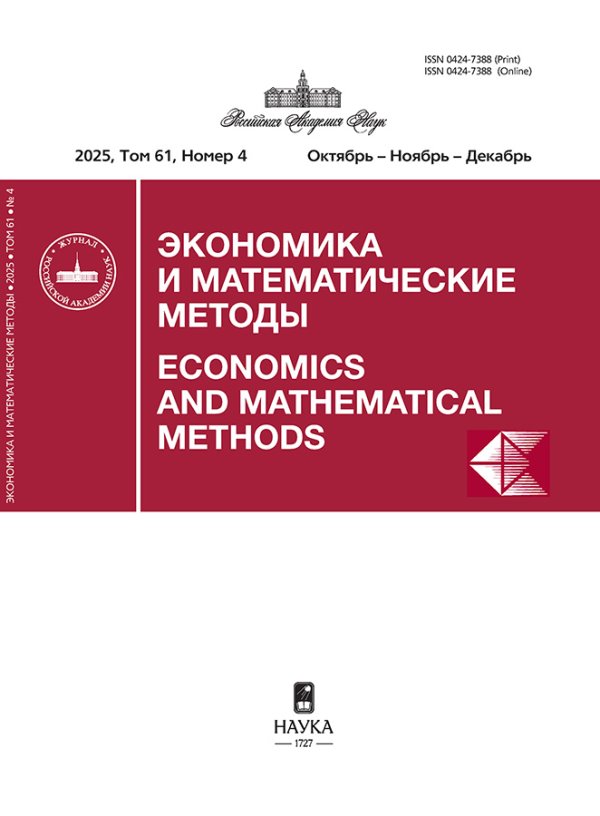Эконофизическая модель распространения инноваций
- Авторы: Жданеев О.В.1, Овсянников И.Р.2
-
Учреждения:
- РАНХиГС при Президенте Российской Федерации
- АО «Центр эксплуатационных услуг», ФГАОУ ВО МФТИ
- Выпуск: Том 60, № 4 (2024)
- Страницы: 102-112
- Раздел: Математический анализ экономических моделей
- URL: https://gynecology.orscience.ru/0424-7388/article/view/653284
- DOI: https://doi.org/10.31857/S0424738824040092
- ID: 653284
Цитировать
Полный текст
Аннотация
Анализ и оценка эффективности инноваций требует развития инструментов моделирования процесса их распространения в отрасли. В данной работе представлена модель распространения инноваций, основанная на физических подходах и описывающая стадии ускоряющегося и замедляющегося роста. Для описания экспоненциального роста используется диффузионная модель, а для логарифмического — электротехническая модель. В работе представлено соответствие физических параметров их экономическим аналогам: размер компании, характеристика скорости обмена информации между фирмами, готовность компании к внедрению инновации, межфирменное влияние и прорывной уровень инновации. Полученная теоретическая модель протестирована на исторических данных внедрения инноваций в топливно-энергетическом комплексе с последующей корректировкой коэффициентов, зависящих от региона внедрения инновации. Разработанная модель применима для описания процесса распространения инноваций в любой отрасли страны, а также при инвестиционном и бизнес-планировании в компаниях и принятии решений об инвестировании в инновационные проекты. При применении данного инструмента в отраслях с низким уровнем инновационной активности прогнозируется повышение уровня высокотехнологического производства и доли организаций, осуществляющих технологичные инновации. На примере топливно-энергетической отрасли России прогнозируется повышение технологичности предприятий и снижение уровня импортозависимости.
Ключевые слова
Полный текст
Об авторах
О. В. Жданеев
РАНХиГС при Президенте Российской Федерации
Автор, ответственный за переписку.
Email: Zhdaneev@rosenergo.gov.ru
Россия, Москва
И. Р. Овсянников
АО «Центр эксплуатационных услуг», ФГАОУ ВО МФТИ
Email: ovsyannikov.ir@phystech.edu
Россия, Москва
Список литературы
- Голышева Е. А., Жданеев О. В., Коренев В. В., Лядов А. С., Рубцов А. С. (2020). Нефтехимическая отрасль России: анализ текущего состояния и перспектив развития // Журнал прикладной химии. Т. 93. № 10. С. 1499–1507. doi: 10.31857/S0044461820100126 [Golysheva E. A., Zhdaneev O. V., Korenev V. V., Lyadov A. S., Rubtsov A. S. (2020). The petrochemical industry of Russia: Analysis of the current state and development prospects. Journal of Applied Chemistry, 93, 10, 1499–1507. doi: 10.31857/S0044461820100126 (in Russian).]
- Цветкова Н. А., Туккель И. Л. (2017). Модели распространения инноваций: от описания к управлению инновационными процессами // Инновации. № 11 (229). Режим доступа: https://cyberleninka.ru/article/n/modeli-rasprostraneniya-innovatsiy-ot-opisaniya-k-upravleniyu-innovatsionnymi-protsessami [Tsvetkova N. A., Tukkell I. L. (2017). Models of innovation diffusion: From description to management of innovation processes. Innovations, 11 (229). Available at: https://cyberleninka.ru/article/n/modeli-rasprostraneniya-innovatsiy-ot-opisaniya-k-upravleniyu-innovatsionnymi-protsessami (in Russian).]
- Цветкова Н. А. (2018). О взаимном влиянии инноваций // Инновации. № 3 (233). Режим доступа: https://cyberleninka.ru/article/n/o-vzaimnom-vliyanii-innovatsiy [Tsvetkova N. A. (2018).On the mutual influence of innovations. Innovations, 3 (233). Available at: https://cyberleninka.ru/article/n/o-vzaimnom-vliyanii-innovatsiy (in Russian).]
- Abrahamson E., Rosenkopf L. (1997). Social network effects on the extent of innovation diffusion: A computer simulation. Organizational Science, 8, 3, 289–309.
- Adiano C., Roth A. V. (1994). Beyond the house of quality: Dynamic QFD. Benchmarking for Quality Management & Technology, 1, 1, 25–37.
- Bass F. M. (1969). A new product growth for model consumer durables. Management Science, 15, 5, 215–227.
- Benhabib J., Perla J., Tonetti C. (2016). The growth dynamics of innovation, diffusion, and the technology frontier. [Report]. N.Y.: New York University. 1057 p.
- Delre S. A., Jager W., Janssen M. A. (2007). Diffusion dynamics in small-world networks with heterogeneous consumers. Computational and Mathematical Organization Theory, 13, 2, 185–202.
- Fuenfschilling L., Truffer B. (2014). The structuration of socio-technical regimes: Conceptual foundations from institutional theory. Research Policy, 43, 772–791. doi: 10.1016/j.respol.2013.10.010
- Galitskaya E., Zhdaneev O. (2022). Development of electrolysis technologies for hydrogen production: A case study of green steel manufacturing in the Russian Federation. Environmental Technology and Innovation, 27, 102517 (in English). doi: 10.1016/j.eti.2022.102517
- Lуpez-Pintado D. (2008). Diffusion in complex social networks. Games and Economic Behavior, 62, 2, 573–590.
- Mahajan V., Peterson R. (1985). Models for innovation diffusion. Quantitative Applications in the Social Sciences. Sage University Paper. Newbury Park: SAGE Publications, Inc.
- Mardani A., Jusoh A., Zavadskas E. K., Cavallaro E. K., Khalifah Z. (2015). Sustainable and renewable energy: An overview of the application of multiple criteria decision making techniques and approaches. Sustainability, 7, 10, 13947–13984.
- Meade N., Islam T. (2006). Modelling and forecasting the diffusion of innovation — a 25-year review. International Journal of Forecast, 22, 514–545.
- Moskalev A., Tsygankov N. (2021). Diffusion model of various modifications of an innovative product. E3S Web of Conferences. EDP Sciences, 320, 03004 (in English).
- Ovsyannikov I. R., Zhdaneev O. V. (2024). Forecast of innovative activity in key areas of energy transition technologies based on analysis of patent activity. International Journal of Hydrogen Energy, 87, 1261–1276. doi: 10.1016/j.ijhydene.2024.08.375 (in English).
- Pelegrin B., Fernandez P., Perez M. D.G. (2014). Profit maximization and reduction of the cannibalization effect in chain expansion. Annals of Operations Research, 1–19.
- Rogers E. M. (2009). Innovation diffusion: Social network models. In: Encyclopedia of complexity science and technology, 4554–4562.
- Tsvetkova N. A., Tukkel I. L. Ablyazov V. I. (2017). Simulation modeling the spread of innovations. 2017 XX IEEE International Conference on Soft Computing and Measurements (SCM). St. Petersburg, Russia, 675–677 (in English). doi: 10.1109/SCM.2017.7970686 Available at: https://ieeexplore.ieee.org/abstract/document/7970686
- Young H. P. (2009). Innovation diffusion in heterogeneous populations: Contagion, social influence, and social learning. American Economic Review, 99, 5, 1899–1924.
- Zhdaneev O. V., Frolov K. N. (2024). Technological and institutional priorities of the oil and gas complex of the Russian Federation in the term of the world energy transition. International Journal of Hydrogen Energy, 58, 1418–1428 (in English). doi: 10.1016/j.ijhydene.2024.01.285
Дополнительные файлы








